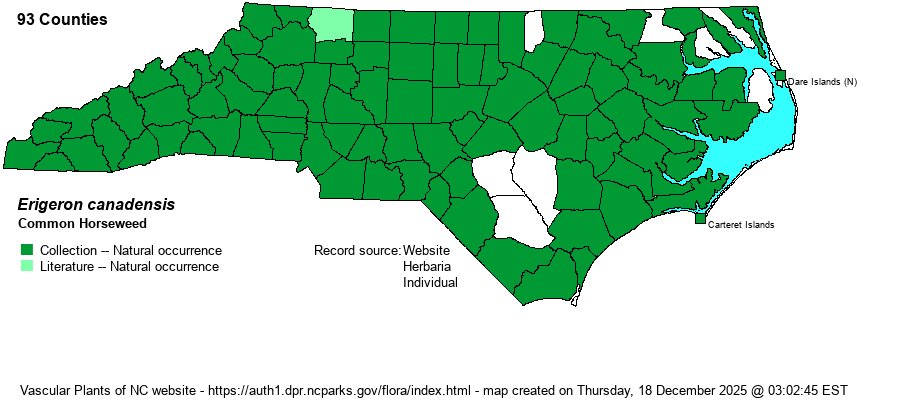| Author | L. | |
| Distribution | Throughout the state. The lack of collections for a number of Coastal Plain counties is puzzling; the "hole" in the southern Coastal Plain certainly cannot be real.
Que. to B.C., south to FL, TX, and CA; Mex., C.A. Adventve elsewhere. | |
| Abundance | Generally common, to often abundant, in the Mountains and Piedmont, and probably less so in the Coastal Plain, where the very similar Southern Horseweed (E. pusillus) is widespread. This is the dominant pioneer successional plant in Mountain and Piedmont fields a year or two after abandonment. | |
| Habitat | Although a native species, Common Horseweed is one of the weediest plants we have. It can be found in roadsides, powerlines, waste ground, clearings, scrapes, forest openings, trailsides, yards, pastures, fields, cropfields, etc. Its true natural habitats are unknown. |
| Phenology | Flowering and fruiting June-November. | |
| Identification | Common Horseweed can be most any height, but mostly 3-7 feet. Stems are crowded with slender leaves, the lower and middle ones tending to turn brown and drop during the growing season. The inflorescence is open, multi-branched, with abundant small heads 4-5 mm high. Heads have about 30 whitish disk florets. Southern Horseweed (E. pusillus) is essentially a miniature version of Common Horseweed, but has distinctive purple tips to the flower head bracts. It also has more spreading branches in the inflorescence, as opposed to strongly ascending to erect ones in Common Horseweed. The exotic Hairy Fleabane (E. bonariensis) is quite similar but is copiously hairy (vs. glabrate, sometimes hairy) and has about 50 disk florets. | |
| Taxonomic Comments | Some authors place it in the genus Conyza (FNA). The species was originally placed in Erigeron, often moved into Conyza, and now generally moved back to Erigeron.
| |
| Other Common Name(s) | Horseweed. However, with the splitting out of E. pusillus as a separate species, the name of Horseweed needs a modifier. Canadian Horseweed or Canada Horseweed are other names. | |
| State Rank | S5 | |
| Global Rank | G5 | |
| State Status | | |
| US Status | | |
| USACE-agcp | FACU link |
| USACE-emp | FACU link |

